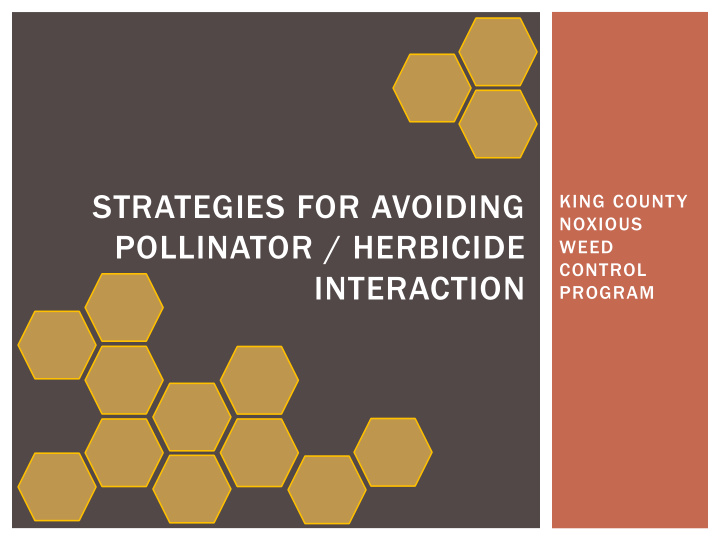



STRATEGIES FOR AVOIDING KING COUNTY NOXIOUS POLLINATOR / HERBICIDE WEED CONTROL INTERACTION PROGRAM
KING COUNTY NOXIOUS WEED CONTROL BOARD POLICY ON NOXIOUS WEED CONTROL AND BEES “In partnership with the Washington State Noxious Weed Control Board, we have adopted practices to minimize impacts to bees and other native pollinators, while continuing to fulfill our obligations in King County .” Through Best Management Practices and Integrated Pest Management we are able to perform our work with respect to PC: Roger Butterfield pollinators and still reach our goals for control
KING COUNTY NOXIOUS WEED CONTROL BOARD POLICY ON NOXIOUS WEED CONTROL AND BEES Timing is everything! “…the KCNWCP will make every reasonable effort to schedule control work so that it will minimize potential interaction with bees. As such, staff members will make every reasonable effort to avoid contact with pollinators where flowering plants are located and will schedule treatments during non- PC: Justin Brooks flowering periods and during 1 st year knotweed treatment at Snoqualmie Falls. times when the bees will not KCNWCP crew member applies foliar spray late in the be active .” season after flowering.
KING COUNTY NOXIOUS WEED CONTROL BOARD POLICY ON NOXIOUS WEED CONTROL AND BEES Control and Replace! “…the KCNWCP is committed to working closely with landowners in project areas to re-establish desirable native and non-invasive plant species to replace the controlled noxious weeds. These non-invasive and native species offer an alternative pollen and nectar source that are not harmful, state regulated noxious weeds. These replacement species offer substantial benefits for bees and pollinators and also PC: mudsongs.org benefit water quality, fish and wildlife — whereas invasive noxious weeds do not .”
UPPER SNOQUALMIE RIVER KNOTWEED PROJECT In the 2016 Season, 2.5 river miles of new project area were added to the Upper Sno. A variety of management strategies were employed to alleviate pollinator/ herbicide interaction on flowering stands of knotweed. Lef t: EarthCorps crew skips through flowering knotweed and makes their way to spray vegetative knotweed upstream.
UPPER SNOQUALMIE RIVER KNOTWEED PROJECT Historic parts of the project area were survey/treated during peak flowering. Left: KCNWCP crew member treats vegetative knotweed on the South Fork Snoqualmie River.
UPPER SNOQUALMIE RIVER KNOTWEED PROJECT Toward the end of the summer we had treated all historic parts of the project area and needed to move into initial treatment areas that still had flowers present. Left: Hollow stem injection can be used while pollinators are active on flowers.
UPPER SNOQUALMIE RIVER KNOTWEED PROJECT Once flowering was almost over, crews would spray knotweed in the early morning and switch to injection during the heat of the day when pollinators were most active. Left: KCNWCP crew member treats knotweed from the underside of the canopy, preventing spray from getting on flowers.
UPPER SNOQUALMIE RIVER KNOTWEED PROJECT Once flowering was complete we were able to finish the final stretch of the new project area before the first frost! Left: KCNWCP crew member sprays knotweed after flowers have fallen off.
UPPER SNOQUALMIE RIVER KNOTWEED PROJECT After a site has been in treatment for at least three years, it is a potential candidate for native plant restoration. Left: Restoration planting site at Olallie State Park on the South Fork Snoqualmie River. Installation by Mountains to Sound Greenway Trust in 2011.
STRATEGIES FOR AVOIDING POLLINATOR / HERBICIDE INTERACTION SUMMARY Choose an herbicide that is Low most effective at controlling the target noxious weed, Toxicity while exhibiting the lowest Herbicides risk and toxicity characteristics Schedule foliar application when flowers are not present or pollinators are not actively Timing foraging. Hollow stem injection may also be used during flowering periods Replace Noxious Replace invasive weeds with desirable vegetation that Weeds meets the needs of foraging with Native pollinators Plants
Recommend
More recommend